“Archive Status” update.
Following up to this post from August 24th, the BBTI site has been updated.
When you go there now, at the top of each page you’ll see this notice:
ATTENTION: Effective Sept 1, 2020, the BBTI Project is in “Archive Status.” No further tests will be conducted, but we will maintain this site and data for the use of the firearms community. Thank you.
In addition, we’ve removed the “Contact Us” and “Donate” options. There are costs associated the continuing to host the site, but I’d rather just pay those myself than give anyone the hope of making a donation towards future testing. I do want to thank those who have made contributions towards offsetting some of our expenses in the past. Likewise, thanks to those who contacted us with questions, corrections, and suggestions. It hasn’t always been possible to respond to each one, but your thoughts have been appreciated.
Cheers!
Jim Downey
Spinning wheel got to go round.*
I was surprised when one of the other BBTI guys said that he had found a reproduction wheellock on Gunbroker recently, and that it wasn’t even horribly expensive. This one:

Wheellock with Diablo double-barrel pistol.
I was surprised, because there aren’t many reproduction wheellocks out there that I was aware of. It’s a quirky firearm design from the 16th century (Ian from Forgotten Weapons has an excellent primer on Wheellock history and operation in this video), which was superseded by reliable & cheaper flintlocks, and not too many people are familiar with them. But it seems that a firm by the name of Mendi was producing them in Spain in the 1980s. This one is stamped along the top of the barrel “Jacobi Iserlohn”, which is a firm selling historical firearms in Iserlohn, Germany. You might be able to make out the stamp in this image:

Jacobi Iserlohn.
We didn’t know much about the gun beyond what was stamped on it — it came with no paperwork or anything (which, being black powder, it didn’t need). As you can see in the image above, it says that it is “CAL 45”, and a normal .451 lead ball seemed to fit, so …
So we figured we’d try and figure it out and shoot it, of course. The first thing was to check the bore, see if the mechanism worked, etc. Most things checked out fine, though it looked like someone had substituted welding rods clamped between a piece of thick lead sheet for the historical pyrite used to generate sparks. See for yourself:
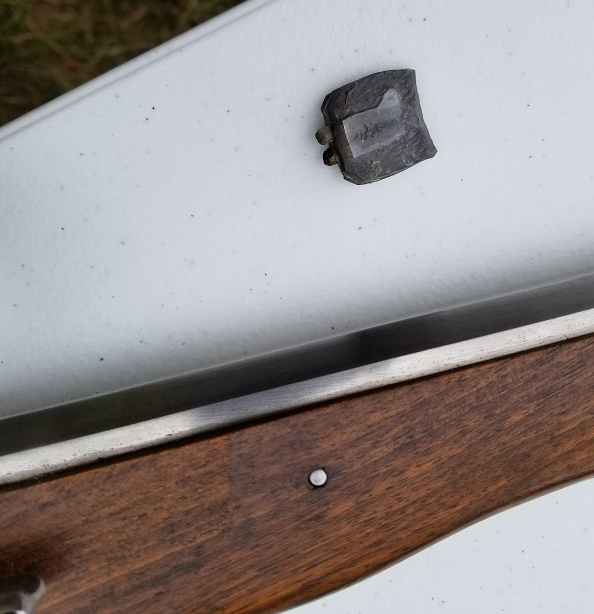
Welding rod?
Which would clamp in this (called the ‘dog’):
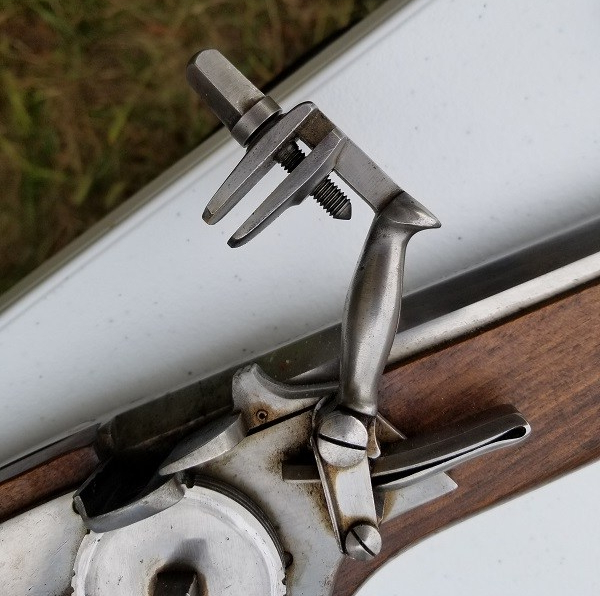
We adjusted the rods so they were equal length and extended far enough to engage the spinning wheel of the mechanism when the dog was lowered. So far, so good.
Next was to test the wheel mechanism. The way a wheellock works is that there’s a spring inside the stock, attached to the inside of the wheel usually by a chain or strap. Using a suitable crank (we didn’t have one that came with the gun, so we used a simple adjustable wrench), you crank the wheel until a ratchet inside locks it into place. We discovered that this gun only needed to be cranked about half a turn before the ratchet clicked. When you pull the trigger the ratchet is released, and the wheel spins.
We tried that, and it seemed to work.
OK, time to load the thing. We elected to start with a mild load typical for other black powder handguns we have in .44/.45 — 30gr of fffg. The lead ball seemed to fit tightly enough into the bore that we went without a patch. All of that went smoothly.
Last was to put some powder in the pan and see if we could shoot it. First, we cranked the wheel into place. Then we put some powder beside where the wheel was, next to the touch-hole. And gave it a try:
Remember, we had no idea what to expect.
At least we got sparks. Just sparks. The powder in the pan failed to ignite. We considered the matter, and decided that we had been too stingy with the powder, that it needed to more or less fill the pan all around where the wheel protruded.
The result:
Excellent! It fired! It hit the target! It didn’t blow up and kill us! Yay!
So each of us had a go:
That last one’s me. And let me share what it felt like.
Mostly, like shooting any similarly sized/powerful black powder handgun, with the gentle push of black powder. But when you pulled the trigger, you could feel a little bit of torque as the wheel released and spun for a moment. It was different than either a flintlock or cap & ball handgun, in that regard. And the delay between pulling the trigger and ignition was about what it’s like with a flintlock, perhaps a little longer.
All in all, it was pretty cool. And it wasn’t something I expected to ever have a chance to actually try, since most of the wheellocks I was aware of were either 300+ year antiques or fairly high-end (and rare) custom reproductions. Needless to say, if you do get a chance to try one of these things, definitely do it.
Jim Downey
* of course.
(Cross posted to my personal blog.)
The Fightin’ Swedes/Swiss.
Two last battle rifles today: the Swedish Ag m/42B in 6.5×55 and the Swiss Schmidt-Rubin Model 1911 rifle.
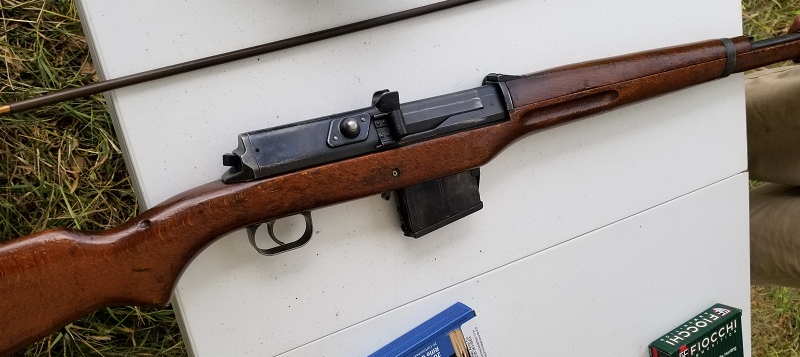
Swedish Automatgevär m/42
We should have done our homework on this.
Why? Because we had no idea about how to operate it. I’ll save you the several videos of us fumbling with it, trying to figure out what the hell made the thing work. Instead, go watch this video of how the mechanism works, if you’re interested.
At least none of us mashed our thumbs, which even Ian at Forgotten Weapons was nervous about (watch his second video there).
Anyway, the Swedish AG m/42B is a direct gas-impingement self-loading rifle introduced in 1942. It’s a little odd in design, but makes sense once you understand it (which I really didn’t until I did research for this post). And it’s fairly simple and robust, so was able to stay in use until the 1960s. Here are a couple of additional images of it:
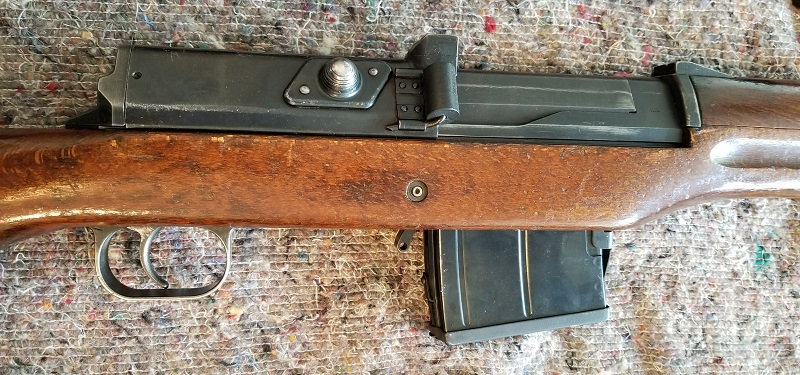
Swedish Automatgevär m/42B

Swedish Automatgevär m/42B
Those odd knob things? That’s the dust cover/bolt carrier, and it’s how you operate the loading mechanism safely. Go watch the video above — trying to explain it is … complicated.
Note the simple range adjustment dial for the sight there on the left (bottom) in front of the receiver. Nice, easy to use. Because that’s one of the great things about this rifle — the 6.5×55 Swedish cartridge is a very flat-shooting round, and the rifle has an effective range out to 800 meters. The rifle is also relatively heavy, so that combined with a simple integrated muzzle break means that it has very light recoil. See for yourself:
This was really a pleasure to shoot, and while I’m not into rifles that much, I could easily see myself having one of these guns.
Schmidt-Rubin Model 1911 rifle
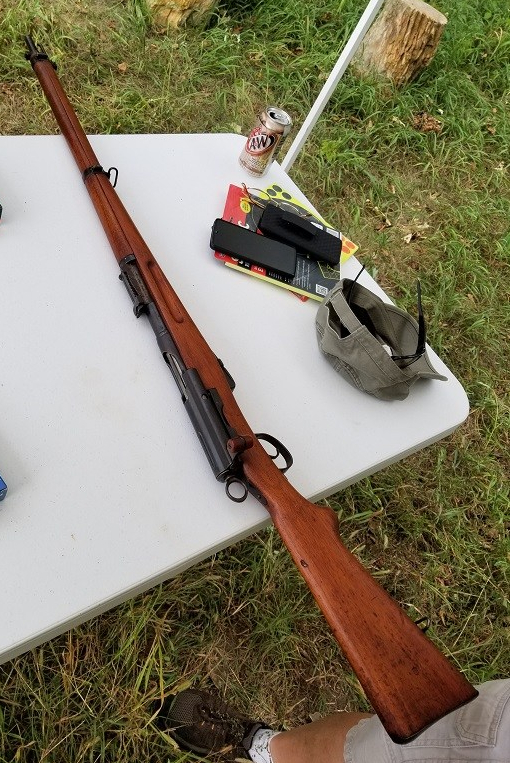
Model 1911
The Schmidt-Rubin was a heavy battle rifle, designed for the long tradition of Swiss sharpshooting. As part of a series of rifles beginning with the Model 1889, the Model 1911 entered service in 1911 (surprise!). Firing a new more powerful cartridge (7.5×55) than the previous models, it had an aimed range out to 600 meters, and a volley range to 2000 meters. It has a straight-pull bolt action (no need to rotate the bolt to unlock it) which is slick and fast.

Schmidt-Rubin Model 1911
It’s easy to operate, easy to shoot well. It was also famously accurate, and is still valued as both a hunting and long distance target rifle. With a 175gr bullet at 2650fps out of the long 30″ barrel generating about 2700ft/lbs of energy, it is perfectly suitable for either. Since the Model 1911 weighs about ten pounds, recoil is modest.
As I’ve said several times with these historic rifle reviews, if you get a chance to shoot either the Swiss Schmidt-Rubin or the Swedish Ag m/42B, do so.
But if it’s the Ag? Watch your thumbs.
Jim Downey
Review: S333 Thunderstruck.
This is the Standard Manufacturing S333 Thunderstruck revolver:

It’s an innovative, 8-round revolver which fires two rounds of .22WMR (.22mag) with one pull of the trigger.
OK, if you like this not-so-little handgun, you might not want to read this review. Just move along and save yourself some time.
No, really.
If you have to think about it, here’s another pic to give you some time:

The actual S333
* * *
For those who’ve stuck around …
… good lord, don’t buy one of these things as a self/home defense gun. If you want it just because it’s kinda geeky and weird, then cool. If you want to actually use it, go spend your money on almost anything else. Seriously.
Why do I say this?
Because, for the ostensible use of the gun as a self/home defense tool, it is almost entirely unsuited. Yeah, that’s my biased opinion, on having shot the thing.
Oh, you want details? Reasons for this opinion? Fair enough.
When I first heard of it, I saw that it was .22WMR, out of a 1.25″ barrel. Now, since it is being shot out of a revolver, you can add in the length of the cylinder, and come up with an overall barrel length of about 3″.
.22WMR out of a 3″ barrel isn’t exactly useless. I mean, it beats harsh words. And, in fairness, it beats your typical .22lr. A little. You can expect about 100-110ft/lbs of energy from it. The best-performing .22lr from the same length barrel is about 90ft/lbs. Same for .25ACP.
And, if you think in terms of having two such bullets fired simultaneously, that gets you up to about 200-220ft/lbs of energy. Not impressive, but I wouldn’t want to be shot by it. I mean, it’s better than .32ACP.
Well, it would be if for one big problem: keyholing.
See, with such a very short barrel, the .22WMR bullets aren’t stabilized. They come out of the barrel, and tumble. If the bullet tumbles upon leaving the barrel, it will quickly lose energy to aerodynamic forces. And likewise, if it hits something more solid, it will also lose energy more quickly. Which will really mess up their effectiveness in penetrating deep enough into an attacker in order to be effective. Because, remember, this is supposed to be a self/home defense gun.
See for yourself:

keyholed!
Yeah, of the 8 bullets I fired (from about 5 yards, aiming at the center of the target), 7 have keyholed.
This is something that almost every review video I watched also noted. The S333 keyholes at least 50% of the time, and usually more.
So let’s go back to the comparison with .32ACP. Keyholing can happen with any caliber and almost any gun, but it tends to be rare in well-designed guns and properly matched ammunition. So, usually, you can rely on fairly consistent penetration out of .32ACP. Which, according to independent testing by Brass Fetcher, will give you 7-10″ of penetration in 20% ballistic gel. And .22WMR will do about as well.
But not if it keyholes. Which it does, out of the S333.
Now, Standard Manufacturing has said that this is something that they’re working to correct. So perhaps later versions of the gun will not have this problem.
I still wouldn’t want it. Why?
The S333 is as large and weighs (18oz) as much as many common compact 9mm semi-auto handguns. It’s larger and weighs more than most small .380 semi-auto handguns. It’s larger and weighs more than most small frame .38/.357 revolvers. Any of those alternatives offer much more potent cartridges, even in comparison to two simultaneous .22WMR rounds. And with the S333, you have four shots — your typical small revolver will be 5 or 6, and small semi-auto guns are typically 6 or more.
The S333 is also awkward and difficult to shoot. The unusual “two finger” trigger really changes how you can grip the revolver, changing how you aim and control it. It’s also a very long and very hard trigger pull — something in excess of 12 pounds, by most reports. If, like most people, you want to use a second hand to support your shooting hand (which is even more necessary when you only hold the gun with your thumb and two small fingers), about the best thing you can do is grip the wrist of the shooting hand in a modified “cup & saucer” style grip. Otherwise, the fingers of your supporting hand will be in the way of the trigger coming all the way back, which is necessary for it to fire.
Here, see what I mean with this short video of me shooting it:
I think the awkwardness of the grip and the two-finger trigger explains why most people tend to shoot the revolver high and to the right when they first encounter it. All three of us at BBTI did. Almost every review video I watched had the same thing.
I’m sure you could learn to adapt to this, and develop a secure and reliable method of shooting the gun with practice. But as a “grab it and use it” self-defense gun, it’s a problem.
One minor note while the video above is fresh in mind: did you notice the amount of flash in two of the shots? Yeah, that’s another factor of such short barrels with the .22WMR. That was while shooting it on a typical partly cloudy day in the middle of the morning. Not a major problem, but something to register.
One last thing: price. As you can see on the first pic, this particular S333 sold for $419.99, which is just under the MSRP. So while it isn’t really pricey, it isn’t cheap. In fact, it seems to be a very solid and well-made gun. The fit and finish were good. The minor problems we had with it were probably just because it was brand new (it hadn’t been fired previously). The trigger is, as noted, long and very heavy, but reasonably smooth if a little mushy. So, overall, if you wanted one of these just because it’s unique and quirky, then I think it’s a reasonably-priced gun.
But if you are looking at it as a self/home defense gun? Or even as a “back-up” for that use?
I think you have much better options.
Jim Downey
-
Archives
- April 2024 (1)
- March 2024 (1)
- May 2023 (4)
- April 2023 (1)
- August 2022 (1)
- July 2022 (3)
- May 2021 (1)
- March 2021 (1)
- December 2020 (1)
- September 2020 (4)
- August 2020 (10)
- July 2020 (1)
-
Categories
- .22
- .223
- .22WMR
- .25 ACP
- .30 carbine
- .32 ACP
- .32 H&R
- .327 Federal Magnum
- .357 Magnum
- .357 SIG
- .38 Special
- .380 ACP
- .40 S&W
- .41 Magnum
- .44 Magnum
- .44 Special
- .45 ACP
- .45 Colt
- .45 Super
- .450 SMC
- .460 Rowland
- 10mm
- 6.5 Swedish
- 9mm Luger (9×19)
- 9mm Mak
- 9mm Ultra
- Anecdotes
- black powder
- Boberg Arms
- Data
- Discussion.
- General Procedures
- historic rifles
- Links
- Revolver
- Shotgun ballistics
- Uncategorized
-
RSS
Entries RSS
Comments RSS